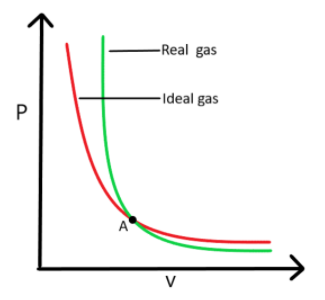
What is meant by an ideal gas and a real gas? What are the causes of the deviation from ideal gas behavior? Plot a graph between pressure and volume for ideal gases and real gases.
Answer
558k+ views
Hint:If we know whether the gas is ideal or real, we can predict the behavior of their intermolecular attractive forces, and the volume occupied by those gases within a system. An Ideal gas, as the names go behaves ideally, under any given temperature and pressure.
Complete answer:
What is an ideal gas?
An ideal gas will follow all the gas laws (i.e., Boyle’s law, Charles’s law, and Avogadro’s law), under a very wide range of temperature and pressure. Ideal gas also follows the kinetic theory of gases which states, there will be negligible amount of volume occupied (\[ \approx \]0) by each gas molecule and that there would be no attractive forces between the gas molecules. Both of the statements are incorrect and hence we have the concept of real gases.
What is a real gas?
A real opposite does not follow the gas law under a wide range of temperature and pressure, and it also disobeys the kinetic gas equation. Eg., if we compress a real gas, the pressure will increase between the gas molecules, which will result in the dominance of attractive forces, and the gas will convert into liquid (condensation), which is contradictory to the “no attractive forces” statement by the kinetic theory of gases.
There are two conditions under which a real gas deviates from the ideal gas behavior these are;
1. Low temperature
2. High pressure
The graph of a real and ideal gas is drawn below, at a constant temperature.

Point ‘A’ in the graph shows the intersection, where the real gas can show ideal behavior.
Note:
The concept of real gas is hypothetical means there is no such gas which can show ideal behaviors under a wide range of temperature and pressure. However, a real gas can show ideal behavior for a shorter range of temperature and pressure, meaning at low pressure and high temperature a real gas can show ideal behavior.
Complete answer:
What is an ideal gas?
An ideal gas will follow all the gas laws (i.e., Boyle’s law, Charles’s law, and Avogadro’s law), under a very wide range of temperature and pressure. Ideal gas also follows the kinetic theory of gases which states, there will be negligible amount of volume occupied (\[ \approx \]0) by each gas molecule and that there would be no attractive forces between the gas molecules. Both of the statements are incorrect and hence we have the concept of real gases.
What is a real gas?
A real opposite does not follow the gas law under a wide range of temperature and pressure, and it also disobeys the kinetic gas equation. Eg., if we compress a real gas, the pressure will increase between the gas molecules, which will result in the dominance of attractive forces, and the gas will convert into liquid (condensation), which is contradictory to the “no attractive forces” statement by the kinetic theory of gases.
There are two conditions under which a real gas deviates from the ideal gas behavior these are;
1. Low temperature
2. High pressure
The graph of a real and ideal gas is drawn below, at a constant temperature.

Point ‘A’ in the graph shows the intersection, where the real gas can show ideal behavior.
Note:
The concept of real gas is hypothetical means there is no such gas which can show ideal behaviors under a wide range of temperature and pressure. However, a real gas can show ideal behavior for a shorter range of temperature and pressure, meaning at low pressure and high temperature a real gas can show ideal behavior.
Recently Updated Pages
Why are manures considered better than fertilizers class 11 biology CBSE

Find the coordinates of the midpoint of the line segment class 11 maths CBSE

Distinguish between static friction limiting friction class 11 physics CBSE

The Chairman of the constituent Assembly was A Jawaharlal class 11 social science CBSE

The first National Commission on Labour NCL submitted class 11 social science CBSE

Number of all subshell of n + l 7 is A 4 B 5 C 6 D class 11 chemistry CBSE

Trending doubts
Differentiate between an exothermic and an endothermic class 11 chemistry CBSE

10 examples of friction in our daily life

One Metric ton is equal to kg A 10000 B 1000 C 100 class 11 physics CBSE

Difference Between Prokaryotic Cells and Eukaryotic Cells

1 Quintal is equal to a 110 kg b 10 kg c 100kg d 1000 class 11 physics CBSE

State the laws of reflection of light




